Varying Focus over a Series of Photos (Focus Shift Shooting)
Use the [] item in the photo shooting menu to vary focus automatically over a series of photographs. This feature can be used to take photos that can later be copied to a computer and combined using third-party focus-stacking software.
Focus Shift Shooting Options
|
Option |
Description |
|---|---|
|
[] |
Start shooting. Shooting will take the selected number of shots, changing the focus distance by the selected amount with each shot. |
|
[] |
Choose the number of shots (maximum 300). |
|
[] |
Choose the amount the focus distance changes with each shot. |
|
[] |
The time between shots, in seconds. Select [] to take photos at up to about 3 fps. To ensure the correct exposure when using a flash, choose an interval long enough for the flash to charge. |
|
[] |
If [] is selected, the camera will lock exposure for all images at the setting for the first frame. |
|
[] |
Select [] to silence the shutter and eliminate the vibrations it produces during shooting.
|
|
[] |
Highlight either of the following options and press 2 to select or deselect:
|
-
Use an AF‑S or AF‑P lens.
-
Choose a release mode other than E.
-
For best results, we recommend that you choose mode A or M so that aperture does not change during shooting. Focus shift is not available in b and EFCT modes.
-
We recommend that you stop aperture down two or three stops from the maximum.
-
We recommend that you take all shots at the same ISO sensitivity.
-
Take a test shot at current settings and view the results.
-
We recommend using a tripod and disabling lens vibration reduction (VR).
-
To ensure that shooting is not interrupted, use an optional AC adapter and power connector or a fully-charged battery.
-
When taking photos with your eye from the viewfinder and [] selected for [], remove the rubber eyecup and cover the viewfinder with the supplied eyepiece cap to prevent light entering via the viewfinder interfering with photographs and exposure (Cover the Viewfinder).
Focus-Shift Photography
-
Rotate the focus-mode selector to AF.
Focus shift is not available with manual focus lenses.
-
Focus.
-
The camera takes a series of shots starting from a selected focus position and continuing toward infinity. The starting focus position should be slightly in front of the closest point on the subject.
-
Do not move the camera after focusing.
-
-
Highlight [] in the photo shooting menu and press 2.
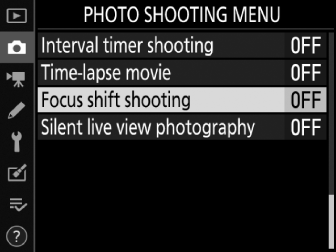
-
Adjust focus shift settings.
Adjust focus shift settings as described below.
-
To choose the number of shots:

Highlight [] and press 2.

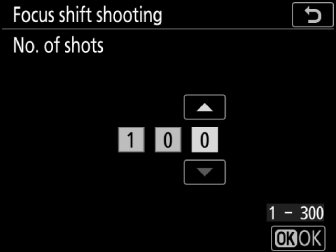
Choose the number of shots (max. 300) and press J.
-
We recommend taking more shots than you think you’ll need and winnowing them down during focus stacking. More than 100 shots may be required for photographs of insects or other small objects, while only a few are needed to photograph a landscape from front to back with a wide-angle lens.
-
-
To choose the amount the focus distance changes with each shot:
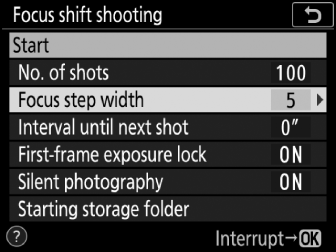
Highlight [] and press 2.

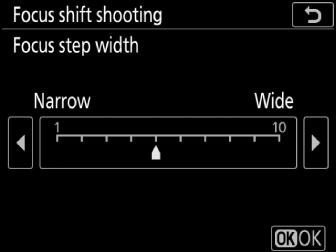
Press 4 to reduce the focus step width, 2 to increase. Press J to proceed.
-
A value of 5 or less is recommended, as higher settings increase the risk that some areas will be out of focus when the shots are stacked. Try experimenting with different settings before shooting.
-
-
To choose the interval between shots:
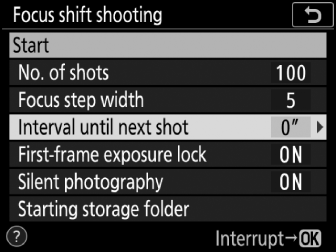
Highlight [] and press 2.

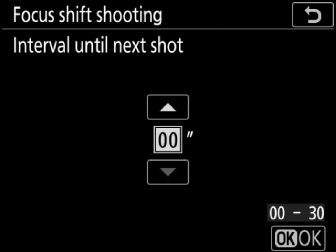
Choose the number of secodns between shots and press J.
-
Select 00 to take photos at up to approximately 3 fps. A setting of 00 is recommended when shooting without a flash; to ensure the correct exposure when using a flash, choose an interval long enough for the flash to charge.
-
-
To enable or disable first-frame exposure lock:
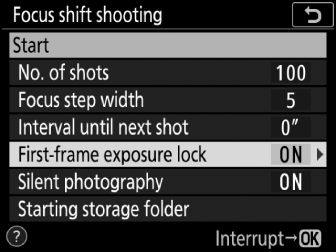
Highlight [] and press 2.

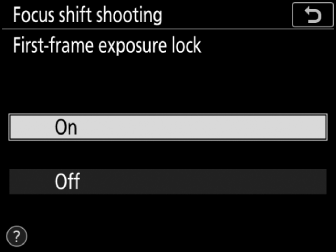
Highlight an option and press J.
-
[] is recommended if lighting and other conditions will not change during shooting, [] when photographing landscapes and the like under variable lighting.
-
Selecting [] locks exposure at the value for the first shot, ensuring that all photos have the same exposure. Large changes in subject brightness during shooting may however result in apparent variations in exposure. This can be addressed by selecting [].
-
-
To enable or disable silent photography:
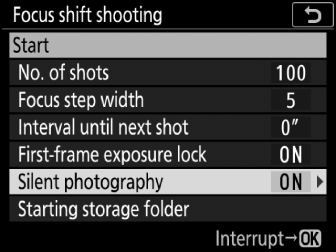
Highlight [] and press 2.

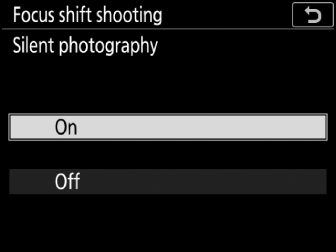
Highlight an option and press J.
-
If [] is selected, the only time the sound of the shutter or mirror will be heard is when the mirror is raised or lowered at the start and end of shooting.
-
-
Choose start folder options:
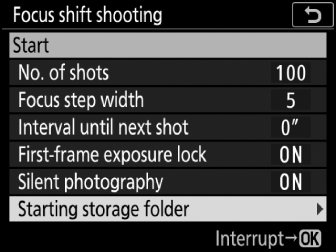
Highlight [] and press 2.

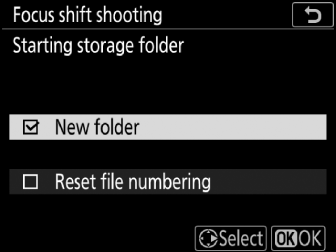
Highlight options and press 2 to select or deselect. Press J to proceed.
-
Select [] to create a new folder for each new sequence, [] to reset file numbering to 0001 whenever a new folder is created.
-
-
-
Start shooting.
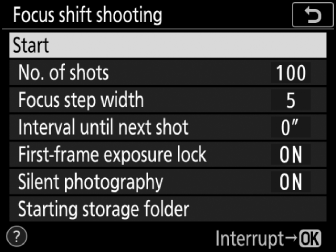
Highlight [] and press J. Shooting starts after about 3 s. The camera takes photographs at the selected interval, starting at the focus distance selected at the start of shooting and progressing out toward infinity by the selected focus step distance with each shot. Shooting ends when the selected number of shots has been taken or focus reaches infinity. To end shooting before all shots have been taken, select [] for [] in the photo shooting menu or press the shutter-release button halfway or press the J button between shots.
-
The shutter speed and the time needed to record the image may vary from shot to shot. As a result, the interval between a shot being recorded and the start of the next shot may vary.
-
Regardless of the option selected for Custom Setting c2 [], the standby timer will not expire while shooting is in progress.
-
If you are using a flash, choose an interval longer than the time needed for the flash to charge. If the interval is too short, the flash may fire at less than the power needed for full exposure.
-
If shooting cannot proceed at current settings, for example because shutter speed is set to A (bulb) or % (time), a warning will be displayed.
-
Changing camera settings while focus-shift photography is in progress may cause shooting to end.
Shooting and menu settings adjusted between shots. Note, however, that the monitor will turn off approximately 2 s before the next shot is taken.
Because depth of focus is reduced at short focus distances, we recommend choosing smaller focus steps and increasing the number of shots when photographing subjects close to the camera.
Immediately before each shot taken during focus-shift photography, the shutter-speed
display in the control panel will show the number of shots remaining.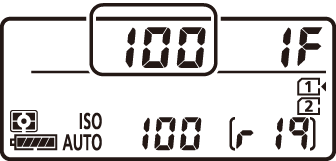
-
Focus-shift photography will not start if:
-
The camera clock is not set
-
An incompatible lens is attached (use only AF‑S or AF‑P lenses)
-
No memory card is inserted
-
-
Focus-shift photography cannot be combined with some camera features, including:
-
Live view
-
Movie recording
-
Long time-exposures (bulb or time photography)
-
The self-timer
-
Bracketing
-
Multiple exposure
-
HDR (high dynamic range)
-
Interval-timer photography
-
Time-lapse movies
-
The negative digitizer
-
Selecting [] for [] disables some camera features, including:
-
ISO sensitivities of [] through []
-
Flash photography
-
Exposure delay mode
-
Long exposure noise reduction
-
Flicker reduction
